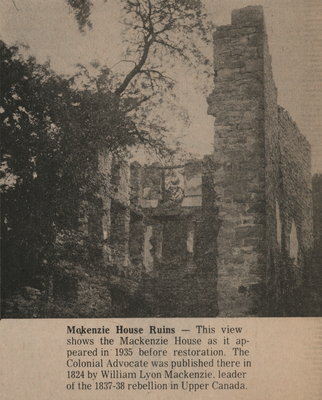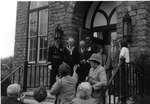The recently announced events for Queenston Day to be held Oct. 6 by the Queenston Community Association reveal what can happen when community's residents band together to preserve history and identity.
Queenston has an illustrious past. It now forms part of the enlarged community of Niagara-on-the-Lake.
The Queenston Community Association was formed that same year to preserve Queenston's history and identity in the face of relentless progress and it has done extremely well.
Two, new blue and gold provincial , historic markers will take their place -alongside the several already conspicuously placed in the village on Queenston Day and both plaques are very significant. The first one to be unveiled that day is to the Queenston Baptist Church which was restored in 1972 as the village library and community centre.
This 130-year-old village landmark, measuring 35 by 50 feet, and built entirely of limestone quarried from the nearby Queenston Quarries, was erected between 1842 and 1845 as the Queenston Baptist Church. A Baptist congregation had been founded here as early as 1808 under the Rev. Elkanah Holmes, a missionary from the United States, but it declined sadly after the War of 1812.
It was revived circa 1831 and through the efforts of two prominent village residents of that era, Reubin Winchell and Solomon Vrooman, this unique Gothic-revival style church home was erected. Its walls were two feet thick and it had a high, plain, stone bell tower, which strangely enough never encased a bell.
It was typical of Baptist churches in Ontario of that time and was to be the village show-place for decades. It served the village Baptist congregation until World War 1, by which time the congregation had dwindled so that it was no longer feasible to operate the church, so it closed in 1918, and, after a 10-year dormant period, was sold to the Queenston Women's Institute in 1928.
The village ladies used it as their meeting-place until 1954, when they in turn, sold it to a Shakespeare Ontario resident, who unfortunately let it deteriorate to such an extent that, by 1967, when local physician, Dr. D. Afrukhteh, purchased it, it was almost a ruin.
He donated it to the town on the condition it be restored to its original historic state and be used as the village library and community centre. This seemingly impossible task became a reality, chiefly through the work of the Queenston Community Association, which was the mainstay behind its restoration.
Today, it is one of the most beautiful, and most used buildings in the community.
The second plaque to be unveiled will be that erected on the Mackenzie house farther up the community's main street, to commemorate the Colonial Advocate. This was the newspaper published there from May 18 until Nov. 18, 1824 by William Lyon Mackenzie, leader of the Rebellion of 1837-38 in Upper Canada.
Moving from York, to Dundas, to Queenston in early 1824, Mackenzie, a shopkeeper by trade, abandoned his regular way of life for a political career, which he launched with his newspaper, the Colonial Advocate.
His newspaper was vitriolic in nature, especially as to his viewpoints on the Family Compact, the ruling class of the day. The Colonial Advocate, as printed in its entirety in 1824, can be viewed on microfilm in the library branch on Victoria Avenue, and it provides an interesting insight on peninsula history of that time. It tells much about the first Welland Canal which was about to start construction at that time under William Hamilton Merritt and it records in detail the commotion created by Mackenzie in June of 1824 at Queenston Heights when he deliberately aroused Sir Peregrine Maitland's anger by placing a copy of his "Colian Rag" (as Maitland called it) in the cornerstone of the almost completed, first Brock's monument.
Mackenzie removed his publishing operation to York in December of 1824 to enjoy a larger circulation and to be, of course, closer to the source of his political antagonists. He was elected the first mayor of Toronto, in 1834, when that community first became a city, but he was not to re-appear again on the Niagara scene until December, 1837, when he occupied Navy Island, in the Upper Niagara River, with his rebel Patriot Army in his abortive attempt to overthrow the government of Upper Canada.
Arrested and exiled in the U.S. until 1849, when he was granted political amnesty, along with his rebel partners, he returned to Canada, again entered politics successfully where he served in a peaceful atmosphere until his death in Toronto in 1861.
Today we enjoy the Responsible Government he envisaged, and fought for in those early columns of the Colonial Advocate. During his one-year's residence at Queenston, he planted two Acacia trees one on each side of the entrance door to his home. These two trees still stand alive today where he planted them, and are suitably marked as to their historical significance.
His old home itself was allowed to deteriorate into a hopeless ruin from the turn of the century and by 1935 only partial remains of its walls were standing. In that year, the Ontario Government and the Niagara Parks Commission undertook the task of rebuilding it to its original state. This costly job took over two years and the house, beautifully restored, was officially opened in June, 1938, by the then Prime Minister, William Lyon Mackenzie King, the grandson of the wily old rebel.
The house, still owned and operated by the N.P.C., contains much memorabilia to Mackenzie, his Colonial Advocate, and Queenston itself. Unfortunately, it is only open to the general public on summer weekends from late June until Labor Day. It will be open on Queenston Day for the plaque unveiling, and it makes a most interesting place to visit.
The Queenston Day ceremonies will start promptly at 2 p.m. in which prominent provincial, regional, and local politicians will take part. Historical sketches on the Baptist Church, the Mackenzie House, and the Colonial Advocate will be given by historians Mrs. Jean Huggins and William Ormsby.
The Georgetown (Ontario), Girls Highland Pipe Band will provide music and a marching drill and the students of Laura Secord School will render songs. A dance later that evening in the new Community Centre will climax the day, which from my point of view, should be most interesting.
In Queenston, they really know how to combine history with recreation, and Queenston Day will unquestionably bear this out.




